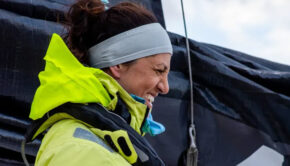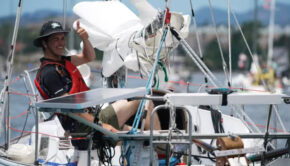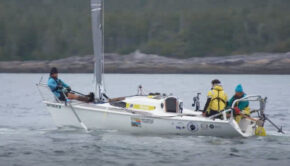R2AK Time Machine Day 18/25
Published on July 3rd, 2020
For five years, the Race to Alaska, a 750-mile course from Port Townsend, Washington to Ketchikan, Alaska, proved that journey trumps destination, and while COVID-19 cancelled the 2020 edition, the Organizing Authority is, for 25 days, sharing their fondest memories from the previous races. Enjoy!
Givin’ the Horns, a cowboy name taken from a cowboy saying, but with a West Coast twist. Because they are not “givin’” to other teams, but rather to their “own inner demons.” And so they give the horns through “introspection, reflection, meditation, and communing with nature.” You’d think that type of belly button research would yield a boatload of playdough action figures wrestling marshmallows, but look at this bio!
Team Givin’ the Horns is the story of a team who chose the high road of self-sufficiency over reaching out for others to help; they fashioned real experience in the face of show-stopping tragedy: a broken boat, in the middle of nowhere. Enjoy their storytelling from the heart of the R2AK ‘middle of nowhere,’ Shearwater.
READ:
2019 Day 8: Mess with the bull, you get the horns (and a broken rudder)
In every buddy cop TV show/Hollywood movie/whatever Netflix is, there’s more than a little oversimplification of motivations of the two main protagonists. One buddy is inevitably the boy scout rising through the ranks as a top ten prospect for chief. Their buddy, a down-bound true heart with the street smarts to make the case but without the ability/social skills to read the room and climb the ladder like a good boy should.
The bad buddy’s world is the streets, and what they don’t need is some rank-climbing suck-up getting in their way of the real work. Over the course of the episode/movie/however long you binge watch, more than the perps getting the bracelets and shoved into the back of the cruiser, the shows work because we all understand the conflict between the need to succeed and the need to be true.
If you cling to the trope-driven narrative, with one trope-driven look it would be easy to write off the Horns as a fair-haired Beach Boys song of So-Cal pablum. Four decent guys, solid sailors all, on a boat of speed and pedigree who charged the course with skills and integrity. There must be at least some repression of the tortured part. Where’s the struggle, the infighting, the cutthroat gamesmanship, the dark underbelly—there’s got to be something, right?
When Team Givin’ the Horns crossed the line on the seventh day of R2AK, they somehow Ponched the John, Bensoned the Stabler, and found the unity moment of the artificial division of the virtuous-rogue and milk-scrubbed do-gooder.
As far as we can tell—from their dockside reception that included fellow competitors, parents, wives, and the bed sheet banner made and held by their adorable children reading “1st place Rudder”—Team Givin’ the Horns might be as good as they are talented, as they are complicated, as they are resourceful, as they are truly enamored to be a part of the R2AK, as we are truly enamored to have them.
It seemed odd to no one at the finish line that the three days of rain ended in sunbreak for their final approach. Rather than anointed all the way, their R2AK evolved into a segmented journey of race, recovery, repair, and return.
The race part was obvious. With Team Pear Shaped Racing’s globally sourced x-wing fighter, and the PNW puppy mill that drove the racing sled of Team Angry Beaver, from their time of entry, Team Givin’ the Horns’ off-the-shelf F-31 was always a contender but never a front runner.
It wasn’t until it arrived for the Port Townsend start that those in the know started to take notice. “Keep your eye on that one,” was Wayne Gorrie’s offered with twinkling eyes on the day before stage one. Wayne won the first set of Steak Knives in 2015 and unrelated is something approaching Godfather of PNW multihulls. “I can tell a good one when I see them.”
The benediction proved out, and their blistering rip across the Strait in Stage One was followed by leading the trail pack in Stage Two.
While the Beavers and Pears grabbed center stage with their two-boat gunfight for pole position to Seymour Narrows, Team Givin’ the Horns stayed within striking distance just off camera working the wind and currents to stay in a solid third place—so close that after working the back eddies of the Campbell River approach, they sent Team Angry Beaver scrambling off the dock and into action to see if they could make progress against the narrows’ waning tide.
In that moment they were too early, but the Horns were the first off the hook, shoved to the middle and ended the waiting game that started the three way tacking duel, close quarters and short tacking against wind, tide, and the inbound cruise ship that took up whatever room was left inside the tidal canyon. They were in pursuit. They had less boat speed and local knowledge than either of the others, but enough skill and experience to hang in for the inevitable when the leaders would meet the consequences of their own mistakes or the business end of a log.
Then the rudder broke.
They were racing head to head with Team Sail Like a Girl, and investigating the cause of an unresponsive tiller showed half of their rudder on the surface; dangling at 90 degrees and held to the part that was still attached by the dry fiberglass fibers that were likely the cause of the break; poor saturation meant that the fibers never got the resin, so never got hard, so never helped structurally but didn’t snap when it broke. So, good news/ bad news.
The wind was blowing them on to a lee shore they dubbed “the rock pile” and they quickly ran through their options. “We thought about bucket steering,” a method to turn the boat by dropping a port and starboard bucket as a way of turning the boat by creating drag on one side or the other, but it’s an open water technique of last resort used when you have plenty of room, and not one particularly suited for clawing off of a set of rocks growing in size as the distance closed. They worked quick to cobble a solution out of the flotsam, and just in case called the Coast Guard.
Calling for help and getting assistance are two different things on the remote parts of BC’s coast. If it’s even available, often assistance has to come from the vessels around you. The nearest boat was Team Sail Like a Girl who heard it all over the VHF and answered the call. This was a race, these were competitors, seas were intense, but the law of the sea dictates rendering assistance. The Girls are racers to the end but mariners to the core, and without a second thought were ready to put the race on hold to keep the Horns out of harm’s way.
“Can you tow them?” was the question from the Coast Guard. “We have two bicycles,” was their answer. What followed was the radio silence that must have been the Ensign of the watch trying to wrap their brains around what that meant and flipping through the book of procedures until they understood that two bicycles worth of thrust wasn’t going to be enough and waved them off. Team Givin’ the Horns would have to get it done themselves.
“It was tough to sail away…we were really conflicted.”
The jury-rigged rudder was completed just in time before they fetched onto the rocks. “I think we had another 20 minutes, tops.” And they limped into safe water and all the way to just outside of Bella Bella where they found a dock and the outpouring of help and internal resolve that would take them the rest of the way.
The next chapter took them through the frenzied journey from, “What the hell just happened?” to navigating hundreds of offers of assistance—from the people on the dock to the dozens of people across the continent who offered to donate their own boat’s rudder, build/buy them a new one, pilots who offered to fly them whatever option they chose. Instead they heard the call of R2AK’s inner spirit of self-reliance and decided to build themselves a new one from whatever they could find—which was both limiting and abundant, depending on how you look at it.
“The shop at Shearwater is basically a WWII hangar for seaplanes with just these huge piles of tools everywhere.” They needed materials and the tools and space to work on them. After finding some plywood and winning over the crusty favor of the maintenance guy (“He basically spent the first half of the day trying to run us over with a forklift.”) they cut it to shape and then, using the best/only polyester resin they could find, laminated and then fiberglassed the blade that would take them away.
“It was a good thing all they had was polyester—the driving thing was to get as fast a cure time as possible.” Rudder done and cured, with a precision and expediency that is rare for any project, let alone field repairs in the middle of a race and in the middle of nowhere, it fit perfectly. After a day of construction and 20 minutes of futzing, they were on their way.
Things slowed down after that. Not in terms of speed, but the way the world slows down when you realize that you’re never going to make it on time and you take your foot off the gas and take in the scenery. They were still competing, but now it was specifically against themselves.
“There’s nothing like this race,” was what they offered in the post-finish moments of reflection and elation. They talked of pedalling their bikes at midnight, their props churning bioluminescence, wolves howling in the fog from some unseen far or near off island. Their Bella Bella reset was just that. Remove the prospect of any prize and they transcended from mere competitors and became one with the race.
R2AK is two races: one defined by racing against others, the other by racing against yourself. Team Givin’ the Horns was the rare team that straddled the two and excelled at both. When they entered the harbor to become the 11th finisher of this R2AK, their beaming smiles and solid disposition made the dockside faithful wonder if in their own way they hadn’t just won it all.
Race details – Previous races – Facebook – Instagram
 What was to be in 2020:
What was to be in 2020:
Race to Alaska, now in its 6th year, follows the same general rules which launched this madness. No motor, no support, through wild frontier, navigating by sail or peddle/paddle (but at some point both) the 750 cold water miles from Port Townsend, Washington to Ketchikan, Alaska.
To save people from themselves, and possibly fulfill event insurance coverage requirements, the distance is divided into two stages. Anyone that completes the 40-mile crossing from Port Townsend to Victoria, BC can pass Go and proceed. Those that fail Stage 1 go to R2AK Jail. Their race is done. Here is the 2020 plan:
Stage 1 Race start: June 8 – Port Townsend, Washington
Stage 2 Race start: June 11 – Victoria, BC
There is $10,000 if you finish first, a set of steak knives if you’re second. Cathartic elation if you can simply complete the course. R2AK is a self-supported race with no supply drops and no safety net. Any boat without an engine can enter.
In 2019, there were 48 starters for Stage 1 and 37 finishers. Of those finishers, 35 took on Stage 2 of which 10 were tagged as DNF.
Source: Race to Alaska









 We’ll keep your information safe.
We’ll keep your information safe.